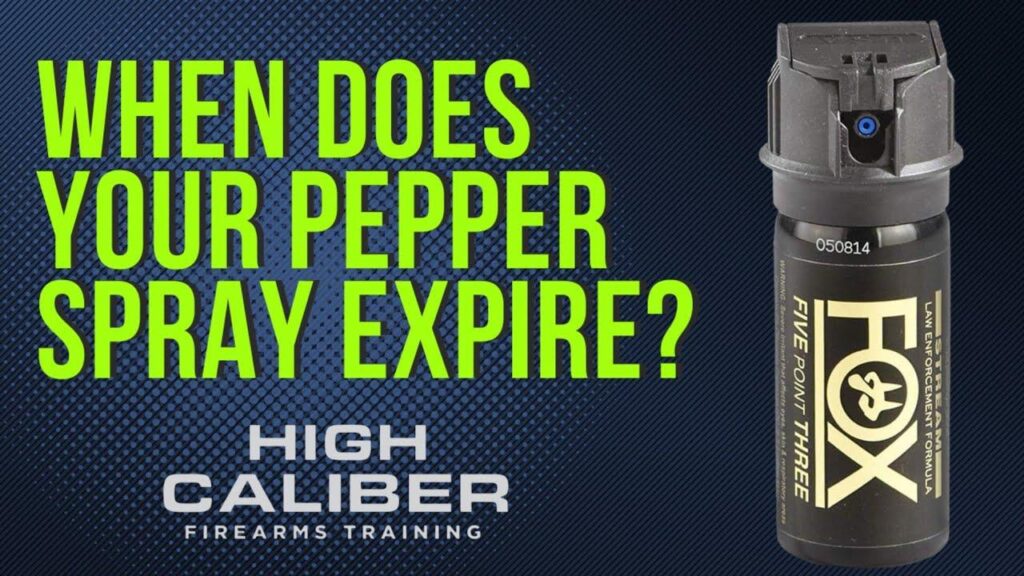Table of Contents
- Understanding the Chemistry Behind Pepper Spray Degradation
- Factors Influencing the Effective Shelf Life of Pepper Spray
- How to Identify Expired Pepper Spray and Assess Its Potency
- Best Practices for Storing Pepper Spray to Maximize Longevity
- To Conclude
Understanding the Chemistry Behind Pepper Spray Degradation
The active ingredient in pepper spray, capsaicin, is a potent irritant responsible for its disabling effects. However, over time, capsaicin molecules undergo chemical transformations due to environmental factors such as heat, light, and oxygen exposure. These reactions can break down the molecular structure, leading to a decrease in potency. Additionally, the propellant and solvent compounds within the canister also degrade, affecting the spray’s pressure and dispersal efficiency.
Several factors contribute to the degradation process, including:
- Oxidation: Exposure to air causes oxidative reactions that alter the chemical makeup of both the active ingredients and the propellants.
- Temperature fluctuations: High or inconsistent temperatures accelerate molecular breakdown and can compromise the container’s integrity.
- Light exposure: Ultraviolet rays catalyze photochemical reactions that diminish the spray’s effectiveness.
Understanding these chemical dynamics highlights why expiration dates on pepper spray are critical-they serve as a guide to ensure the product retains maximum efficacy when it matters most.
Factors Influencing the Effective Shelf Life of Pepper Spray
Several key factors play a crucial role in determining how long pepper spray remains effective after purchase. First and foremost, the formula composition and concentration of active ingredients drastically influence stability. Sprays with higher concentrations of capsaicinoids- the chemical compounds responsible for the irritating effects-tend to degrade over time due to oxidation and environmental exposure. Additionally, the canister’s material and sealing quality impact the shelf life, as metal or high-grade plastic containers reduce the risk of leakage and air intrusion, which can weaken the spray’s potency.
Environmental conditions also heavily affect pepper spray longevity. Storing the canister in a cool, dry place away from direct sunlight can significantly prolong its usable life. Excessive heat, cold, or humidity accelerate chemical breakdown and increase the chance of corrosion. Handling frequency is another consideration; repeated shaking or prolonged exposure to air every time the spray is used can compromise canister integrity. To maximize effectiveness, it’s advisable to periodically inspect the spray and avoid storing it in vehicles or other locations where temperature fluctuations are common.
How to Identify Expired Pepper Spray and Assess Its Potency
First, check the physical condition of the pepper spray canister. Signs of swelling, rust, or corrosion around the nozzle or seams can indicate that the spray is no longer safe or effective. Additionally, an expired pepper spray may have a faded or peeling label that no longer clearly displays the expiration date, making it difficult to determine its freshness. A good rule of thumb is to look for the expiration date stamped directly on the canister or packaging; if you cannot locate a date, it’s best to err on the side of caution and replace the unit.
Assessing the potency without opening the canister is tricky, but certain steps can help you evaluate its reliability. When safe and legal, perform a controlled test spray away from people and pets, ideally outdoors, to check if the spray discharges with the expected force and a visible, concentrated stream or fog. If the spray feels weak, sputters, or fails to discharge effectively, these are signs the active ingredients may have degraded. Keep in mind, however, that pepper spray effectiveness diminishes over time due to exposure to heat, sunlight, and pressure loss, so regularly replacing your canister every few years ensures you are prepared when it matters most.
Best Practices for Storing Pepper Spray to Maximize Longevity
Proper storage is crucial in preserving the effectiveness of your pepper spray over time. Avoid exposing the canister to extreme temperatures, whether hot or cold, as these conditions can compromise the propellant and active ingredients. Ideally, store your spray in a cool, dry place where the temperature stays between 50°F and 77°F (10°C to 25°C). Keep it away from direct sunlight and humid environments, which can degrade the chemical formula and cause the container to corrode or malfunction.
Additionally, ensure your pepper spray remains accessible yet secure. Store it in places where it won’t be subject to frequent jostling or pressure, such as in a purse, glove compartment, or on a keychain, without excessive friction. Consider using a dedicated holster or case to protect the canister from accidental damage or discharge. Some simple but effective tips for maintaining longevity include:
- Checking the canister periodically for dents, leaks, or rust
- Keeping the safety mechanism clean and unobstructed
- Rotating older cans out and replacing them before the expiration date
To Conclude
In summary, understanding the shelf-life and expiration dates of pepper spray is essential for ensuring your personal safety. While these products are designed to be effective for a certain period, factors like storage conditions can impact their potency. Regularly checking the expiration date and replacing old canisters can make all the difference when you need protection the most. Stay informed, stay prepared, and never underestimate the importance of using pepper spray that’s both reliable and up-to-date. Your safety depends on it.Check Our Other Blogs
- StunGun – Your Trusted Source for Stun Guns, Laws, and Self-Defense Tips
- PepperSprayLaws – Your Trusted Resource for Pepper Spray Information
- StunGunLaws – Your Trusted Guide to Stun Gun Legality and Safety




